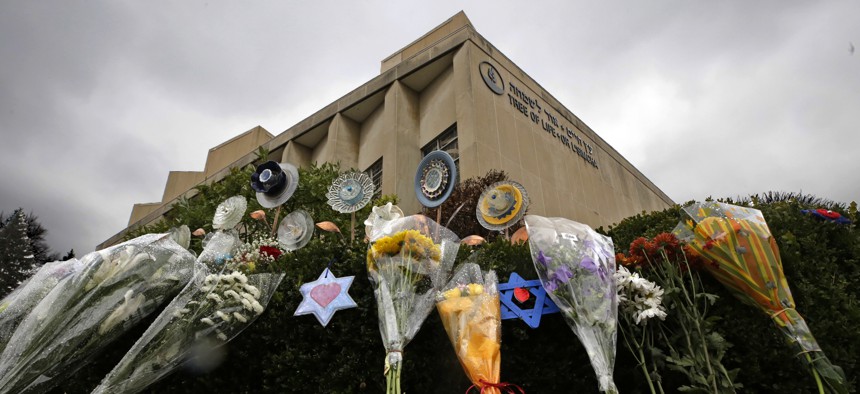
In this Tuesday, Nov. 20, 2018 photo, a makeshift memorial of flowers rests on bushes outside the Tree of Life Synagogue in Pittsburgh. ap photo/gene j. puskar
The Terrorism That Doesn’t Spark a Panic
Americans should react to violence from religious and ethnic minorities with the same sense of proportion they reserve for far-right extremists.
On Friday, the United States ended a 35-day government shutdown, the longest in history, over President Donald Trump’s demand for funding for a wall on the southern border. Hundreds of thousands of workers were missing paychecks; food-bank lines in Washington, D.C., were full of federal employees; and air-traffic controllers were warning of potential catastrophe.
The president’s strategy was predicated on the belief that the more suffering the shutdown inflicted on the American people, the more likely the Democrats were to cave to his demands. But it was all worth it, Trump insists, because the wall is necessary to stem the ceaseless tide of violence from the border. “The only thing that is immoral is the politicians to do nothing and continue to allow more innocent people to be so horribly victimized,” Trump said during his prime-time address in early January.
The president regularly invokes violent crises perpetrated by scary foreigners. The announcement of his candidacy began with the declaration that Mexican immigrants are “bringing drugs; they’re bringing crime; they’re rapists.” He called for a ban on Muslims coming to the United States after an isis-inspired attack in San Bernardino, California. In his border-wall address, he pointed to crimes committed by unauthorized immigrants, whose victims were bludgeoned to death, beheaded, or stabbed, to argue for the necessity of the wall. But there’s one spike in violence that the president rarely acknowledges or even mentions, and it’s the rise in far-right terror that has accompanied his ascension to the White House.
On Wednesday, the Anti-Defamation League released a report finding that attackers with ties to right-wing extremist movements killed at least 50 people in 2018. That was close to the total number of Americans killed by domestic extremists, meaning that the far right had an almost absolute monopoly on lethal terrorism in the United States last year. That monopoly would be total if, in one case, the perpetrator had not “switched from white supremacist to radical Islamist beliefs prior to committing the murder.”
The number of fatalities is 35 percent higher than the previous year, and it marks the fourth-deadliest year for such attacks since 1970. In fact, according to the ADL, white supremacists are responsible for the majority of such attacks “almost every year.” The 2018 attacks include the one at Pittsburgh’s Tree of Life synagogue by a man who blamed Jews for the migrant caravan, the mass shooting at a yoga studio by an “incel” obsessed with interracial dating, and the school massacre in Parkland, Florida, carried out by a student who wished that “all the Jews were dead.”
From 2009 through 2018, right-wing extremists accounted for 73 percent of such killings, according to the ADL, compared with 23 percent for Islamists and 3 percent for left-wing extremists. In other words, most terrorist attacks in the United States, and most deaths from terrorist attacks, are caused by white extremists. But they do not cause the sort of nationwide panic that helped Trump win the 2016 election and helped the GOP expand its Senate majority in the midterms.
When white extremists kill, politicians do not demand that they be racially profiled. They do not call for bans on white people coming to the United States. They do not insist that white people’s freedom of movement be restricted, their houses of worship be surveilled, their leaders be banned from holding public office, or their neighborhoods be “secured” and occupied by armed agents of the state. And they do not demand that taxpayers foot the bill for a massive, symbolic monument that will register America’s official disdain for white people in perpetuity.
And that’s how it should be. It would be immoral to collectively punish white people for the actions of a few extremists—and it would only raise the stature of those extremists, partially legitimize their grievances in the eyes of potential followers, and strengthen their ability to recruit future operatives for further attacks. But that’s not the reason none of those things happen. They don’t happen because, as America’s largest demographic group, white people have the political power and influence to prevent such proposals from even being contemplated. This is a form of political correctness so powerful that it shapes behavior without being mentioned or publicly acknowledged; it is simply the way things work.
By contrast, when religious or ethnic minorities commit such acts, they are seen not as individual extremists, but as representative of the groups to which they belong. As such, collective punishment is believed to be justified. This is, in a basic sense, how American bigotry works: White Christians are simply individuals, while everyone else is vulnerable to demonization by demagogues prepared to exploit the fear of those who are different in exchange for political power.
The correct response to the rise in right-wing terrorism is not a nationwide panic that mirrors those that accompany terrorist attacks by religious or ethnic minorities. It is to extend the same benefit of the doubt, the same proportionate, measured response with which Americans meet attacks from right-wing extremists, to attacks of all sorts. It is to recognize that the constitutional rights of minorities are no less inviolable than the constitutional rights of white Americans, and that anyone who would run on a platform of disregarding those rights is not fit to hold public office.



